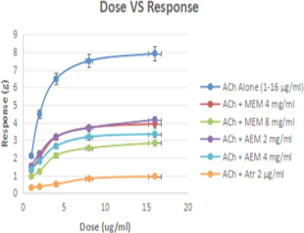Abstract
Garcinia mangostana pericarps have been traditionally used in Southeast Asia for a variety of medicinal conditions. The present study was carried out to determine the anti-motility and antispasmodic effects of methanolic and aqueous G. mangostana extracts (MEM and AEM) on isolated chicken ileum. Extracts were prepared from the pericarp of G. mangostana using maceration technique with methanol and distilled water. Isolated ileum preparations were set up for recording in Tyrode’s solution at 37°C. Dose-response curves were plotted using various doses of agonist as control such as acetylcholine (ACh) and histamine. Atropine, mepyramine and extracts were used as an antagonist. The results showed that methanolic and aqueous extracts possess significant concentration-dependent inhibitory effects (p<0.05) on agonist-induced contractions. The half maximal effective concentration (EC50) of extracts and standard antagonists were higher than the agonist alone. Both methanolic and aqueous extract of G. mangostana exerts anti-motility and antispasmodic effects on smooth muscle contractions. The study provides findings that support G. mangostana can be the potential treatment for diarrhoea and spasm.
Full text article
Authors

This work is licensed under a Creative Commons Attribution-NonCommercial-NoDerivatives 4.0 International License.

